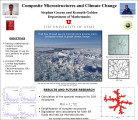1 - 25 of 5
| Creator | Title | Description | Subject | Date | ||
|---|---|---|---|---|---|---|
| 1 |
 |
Chapman, David S.; Harris, Robert N. | Climate change in India inferred from geothermal observations | Temporal variations in surface ground temperature impart a signal to the subsurface thermal regime that is captured in borehole temperature-depth profiles. Seventy temperature-depth profiles in India, located between 12o and 28oN, are analyzed to infer past changes in ground temperature. | Climate change; Borehole temperatures; Surface ground temperature; Surface air temperature; Geothermal observations; India | 2002 |
| 2 |
 |
Greene, Stephen Andrew; Golden, Kenneth M. | Composite microstructures and climate change | Develop mathematical models to better understand the changes in sea ice as it pertains to global climate. Compare Diffusion Limited Aggregates (DLA) and Electrorheological (ER) fluids to sea ice microstructures. | Composite microstructures; Climate change; Effect on climate; Trapeze Interactive Poster | 2010-03-15 |
| 3 |
 |
Reichler, Thomas J. | Expansion of the Hadley cell under global warming | A consistent weakening and poleward expansion of the Hadley circulation is diagnosed in the climate change simulations of the IPCC AR4 project. Associated with this widening is a poleward expansion of the subtropical dry zone. Simple scaling analysis supports the notion that the poleward extent of ... | Hadley cell; Climate change; Subtropical dry zone | 2007 |
| 4 |
 |
Chapman, David S. | Global warming - just hot air? | We know from weather station records that Earth's surface temperature has increased on average by 0.6 degrees C in the last 100 years. The 1990s have been the warmest decade on record. Over the same period, global sea level has increased by 10-20 cm. We know also that planet Earth has an atmosphere ... | Greenhouse Effect; Climate change | 1998 |
| 5 |
 |
Ehleringer, James R.; Belnap, Jayne | Sensitivity of the Colorado plateau to change: climate, ecosystems, and society | The Colorado Plateau is located in the interior, dry end of two moisture trajectories coming from opposite directions, which have made this region a target for unusual climate fluctuations. A multidecadal drought event some 850 years ago may have eliminated maize cultivation by the first human settl... | Colorado Plateau; Biological crust; Climate change; Megadrought; Ranching; Dry crop productivity; Extractive industries; Pueblo Indians; Fremont culture | 2008 |
1 - 25 of 5
